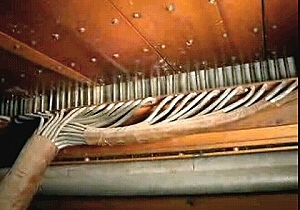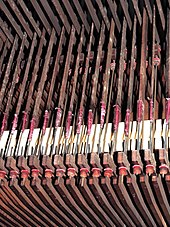
The pipe organ is a musical instrument that produces sound by driving pressurised air through the organ pipes selected from a keyboard. Because each pipe produces a single pitch, the pipes are provided in sets called ranks, each of which has a common timbre, volume, and construction throughout the keyboard compass. Most organs have many ranks of pipes of differing pitch, timbre, and volume that the player can employ singly or in combination through the use of controls called stops.

In music, the organ is a keyboard instrument of one or more pipe divisions or other means for producing tones. The organs have usually two or three, up to five, manuals for playing with the hands and a pedalboard for playing with the feet. With the use of registers, several groups of pipes can be connected to one manual.

A key is a component of a musical instrument, the purpose and function of which depends on the instrument. However, the term is most often used in the context of keyboard instruments, in which case it refers to the exterior part of the instrument that the player physically interacts in the process of sound production.

An organ stop is a component of a pipe organ that admits pressurized air to a set of organ pipes. Its name comes from the fact that stops can be used selectively by the organist; each can be "on", or "off".

Book music is a medium for storing the music played on mechanical organs, mainly of European manufacture. Book music is made from thick cardboard, containing perforated holes specifying the musical notes to be played, with the book folded zig-zag style. Unlike the heavy pinned barrels, which could only contain a few tunes of fixed length, that had been used on earlier instruments, book music enabled large repertoires to be built up. The length of each tune was no longer determined by the physical dimensions of the instrument.

A barrel organ is a French mechanical musical instrument consisting of bellows and one or more ranks of pipes housed in a case, usually of wood, and often highly decorated. The basic principle is the same as a traditional pipe organ, but rather than being played by an organist, the barrel organ is activated either by a person turning a crank, or by clockwork driven by weights or springs. The pieces of music are encoded onto wooden barrels, which are analogous to the keyboard of the traditional pipe organ. A person who plays a barrel organ is known as an organ grinder.

A pedalboard is a keyboard played with the feet that is usually used to produce the low-pitched bass line of a piece of music. A pedalboard has long, narrow lever-style keys laid out in the same semitone scalar pattern as a manual keyboard, with longer keys for C, D, E, F, G, A, and B, and shorter, raised keys for C♯, D♯, F♯, G♯ and A♯. Training in pedal technique is part of standard organ pedagogy in church music and art music.

A theatre organ is a type of pipe organ developed to accompany silent films from the 1900s to the 1920s.

The water organ or hydraulic organ is a type of pipe organ blown by air, where the power source pushing the air is derived by water from a natural source or by a manual pump. Consequently, the water organ lacks a bellows, blower, or compressor.

The word "manual" is used instead of the word "keyboard" when referring to any hand-operated keyboard on a keyboard instrument that has a pedalboard, such as an organ; or when referring to one of the keyboards on an instrument that has more than one hand-operated keyboard, such as a two- or three-manual harpsichord.
Keyboard expression is the ability of a keyboard musical instrument to change tone or other qualities of the sound in response to velocity, pressure or other variations in how the performer depresses the keys of the musical keyboard. Expression types include:

An expression pedal is an important control found on many musical instruments including organs, electronic keyboards, and pedal steel guitar. The musician uses the pedal to control different aspects of the sound, commonly volume. Separate expression pedals can often be added to a guitar amplifier or effects unit and used to control many different aspects of the tone.
The electro-pneumatic action is a control system by the mean of air pressure for pipe organs, whereby air pressure, controlled by an electric current and operated by the keys of an organ console, opens and closes valves within wind chests, allowing the pipes to speak. This system also allows the console to be physically detached from the organ itself. The only connection was via an electrical cable from the console to the relay, with some early organ consoles utilizing a separate wind supply to operate combination pistons.

A crescendo pedal is a large pedal commonly found on medium-sized and larger pipe organs, either partially or fully recessed within the organ console. The crescendo pedal incrementally activates stops as it is pressed forward and removes stops as it is depressed backward. The addition of stops, in order from quietest to loudest, creates the effect of a crescendo. In actual use, the operation of the crescendo pedal usually does not move the draw knobs or stop tabs on the console; the stops are electronically activated inside the organ. Often an indicator light or lights will be present on the console to inform the organist of when the crescendo pedal is activated and how far it is engaged. The crescendo pedal is located directly above the pedalboard, to the right of any expression pedals that may be present.
Registration is the technique of choosing and combining the stops of a pipe organ in order to produce a particular sound. Registration can also refer to a particular combination of stops, which may be recalled through combination action. The registration chosen for a particular piece will be determined by a number of factors, including the composer's indications, the time and place in which the piece was composed, the organ the piece is played upon, and the acoustic environment within which the organ resides.

"Tubular-pneumatic action" refers to an apparatus used in many pipe organs built during the late 19th and early 20th centuries. The term "tubular" refers to the extensive use of lead tubing to connect the organ's console to the valves that control the delivery of "wind" to the organ's pipes. Many such organs are extant 100 or more years after their construction.
Direct electric action is a systems used in pipe organs to control the flow of air (wind) into the organ's pipes when the corresponding keys or pedals are depressed. In direct electric action, the valves beneath the pipes are opened directly by electro-magnet solenoids, while with electro-pneumatic action, the electro-magnet's action admits air into a pneumatic or small bellows which in turn operates the pipe's valve.

Music technology is the study or the use of any device, mechanism, machine or tool by a musician or composer to make or perform music; to compose, notate, playback or record songs or pieces; or to analyze or edit music.

Mechanical music technology is the use of any device, mechanism, machine or tool by a musician or composer to make or perform music; to compose, notate, play back or record songs or pieces; or to analyze or edit music. The earliest known applications of technology to music was prehistoric peoples' use of a tool to hand-drill holes in bones to make simple flutes. Ancient Egyptians developed stringed instruments, such as harps, lyres and lutes, which required making thin strings and some type of peg system for adjusting the pitch of the strings. Ancient Egyptians also used wind instruments such as double clarinets and percussion instruments such as cymbals. In Ancient Greece, instruments included the double-reed aulos and the lyre. Numerous instruments are referred to in the Bible, including the horn, pipe, lyre, harp, and bagpipe. During Biblical times, the cornet, flute, horn, organ, pipe, and trumpet were also used. During the Middle Ages, hand-written music notation was developed to write down the notes of religious Plainchant melodies; this notation enabled the Catholic church to disseminate the same chant melodies across its entire empire.

Charles Brenton Fisk was an American pipe organ builder who was one of the first to reintroduce mechanical tracker actions in modern organ building over electro-pneumatic actions.


















